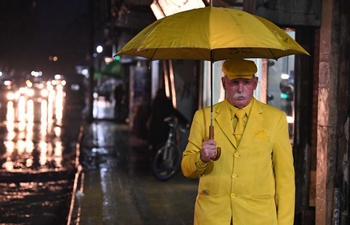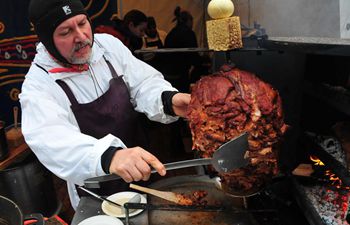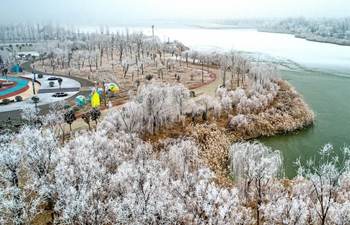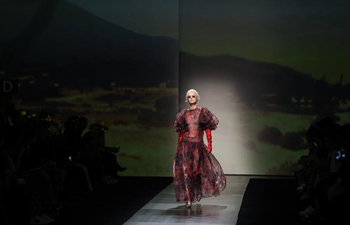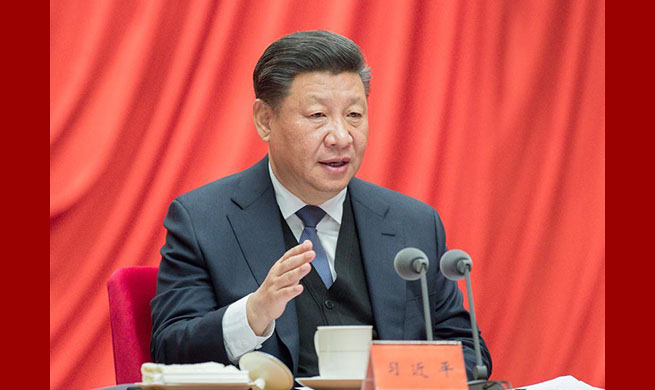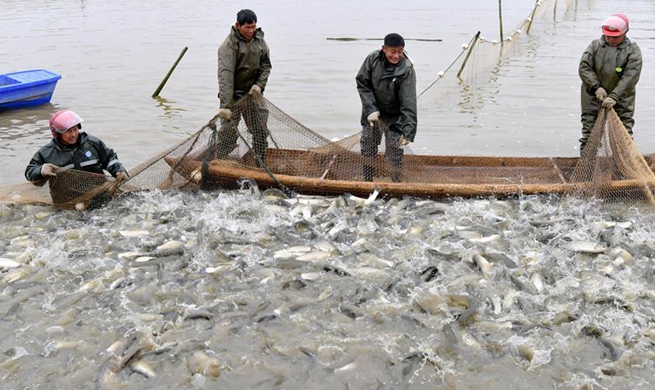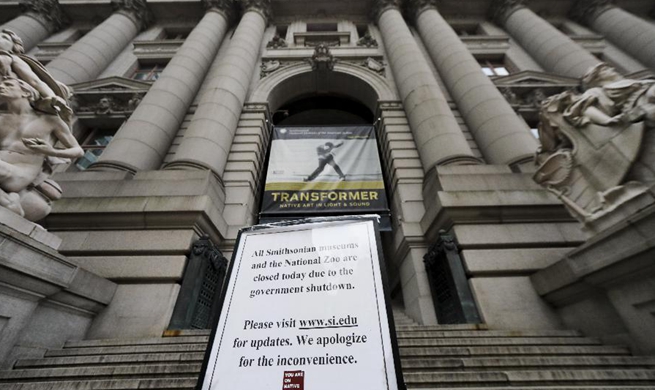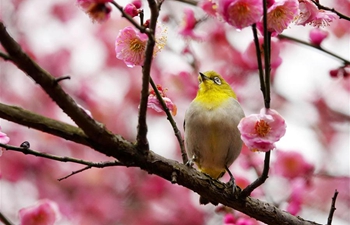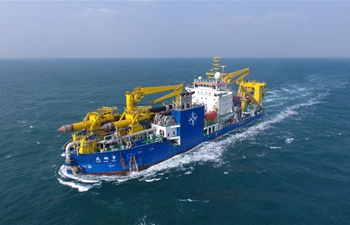By Xinhua writers Cao Kai, Shen Yang and Wu Zhonghao
JINGDEZHEN, Jiangxi Province, Jan. 13 (Xinhua) -- For centuries, the most coveted porcelain from China came out of Jingdezhen's workshops, fashioned from clay made smooth by trained hands, fired in kilns and then transported across the globe.
The works, notably the blue-and-white vases and jade-green celadon bowls, graced the courts of the British, Persians and French. This was one of China's first globalized commodities and greatest export to the world.
The industrial revolution in the West ended China's supremacy, as cheaper porcelain born out of mass production took over the market. The fall of the Qing Dynasty (1644-1912) and wars in the early 20th century broke the artisan culture and lowered its status in global trade.
The craftsmanship, however, never left Jingdezhen, a river town in the eastern province of Jiangxi, and the tradition is being revived at the roots. Studios and workshops have popped up around town and in the surrounding valleys. Some of the new artisans hope to profit from their skills since the country's middle-class boom brings a greater demand for porcelain.
Ryan Labar, an American ceramic artist, said coming to Jingdezhen is like "a son returning home."
The 43-year-old set up a studio three years ago in Taoxichuan, a renovated porcelain factory that unifies industrial heritage, ceramic and arts-crafts galleries and studios as well as restaurants, cafeterias and hotels.
Partnering with a young Chinese businessman, Labar established Lab Artz, a 260-square-meter workshop where he plans to house more artists and offer ceramics classes.
"There is a can-do attitude in China that pushes new ideas into reality," said Labar, who is fond of using traditional methods to make contemporary art.
Labar said his works, unlike traditional Chinese works that have concrete shapes, are very abstract. Though he has not sold a piece in Jingdezhen, his works are a hit in museums, hotels and galleries in Beijing, Shenzhen and Hong Kong, with the highest piece priced at 100,000 yuan (14,515 U.S. dollars).
There is a term for young artists like Labar: jingpiao, or floating population in Jingdezhen.
According to Zhong Zhisheng, the city's Party secretary, 30,000 jingpiao are currently living in Jingdezhen, including 5,000 foreigners.
The city now boasts of 6,773 ceramic enterprises and workshops. Some 150,000 people work in the porcelain-related industry, nearly a quarter of the urban population.
"Jingdezhen is still the global ceramic innovation and exchange center, " said Zhong, "The dream of revival is always in the hearts of the Jingdezhen people."
TRANSITION ON THE WAY
Although there is a 1,700-year history of porcelain making, the industry remained largely hand-made until 1958 when the first mechanized porcelain making plant went into operation.
Jingdezhen was once an important porcelain export base which suffered from drastic drops in profits in the 1990s when the state-owned factories lost their edge over their coastal counterparts who had better equipment and technology.
Workers were laid off, and factories closed one after the other. Yuzhou Porcelain Factory, where Taoxichuan was built, was one of them.
Piles of white porcelain plates under the trees beside a grandeur hotel in Taoxichuan tell the sad story of the once flourishing state-owned factories.
"These are the last batch of ceramic products made by the Yuzhou Porcelain Factory. Most of them are inferior products," said Wang Songshou, former head of the factory.
More than 60,000 technicians and workers left the city and fled to other porcelain making areas in the late 1990s and early 2000s. As a city that relies on porcelain, Jingdezhen fell into a recession.
To continue the hand-made porcelain tradition or shift to construction and bathroom ceramics like in the coastal areas was a tough decision for the city.
Like many other Chinese cities, many obsolete factories and old alleys were demolished in the first 10 years of the 21st century for real estate development, a cash cow for the local government.
In 2011, administrators began to realize the high-rise buildings would not bring lasting prosperity.
"Each alley and chimney are precious resources and fortunes recording the city's history," said Liu Zili, general manager of Jingdezhen Ceramic Culture Tourism Group and former deputy head of the municipal porcelain industry development bureau."You will never have another Jingdezhen that owns a millennium-old culture."
The local government invited global planning experts to seek a path to the city's future. The abandoned factories have been turned into incubators that attract capital, information, technology and talents.
Taoxichuan, where 22 old workshops with varying style structures and kilns were located, was renovated into an art zone. Over 450 million yuan has been invested in Taoxichuan since 2013, turning it into an art community where over 5,000 young people live.
To protect and enhance its unique hand-made porcelain industry, the city opened a porcelain industrial park named Mingfangyuan in 2015 to house time-honored porcelain manufacturing workshops, both for production and tourism.
Zhu Xiaoping, an eighth-generation inheritor of traditional porcelain making, was among the first batch of masters to move to his new villa-like workshop from his humble one in the downtown.
With a formula inherited from his predecessors, Zhu successfully replicated the rough red glaze, which was extremely rare even in the ancient royal kilns. Its refined noble character quickly appealed to a large number of collectors and has been chosen as China's national gifts for foreign leaders.
"Porcelain flourished when China was strong. It went into decline when China was weak," said Zhu. "Thanks to government support for craftsmen, Jingdezhen is flourishing again."
Meanwhile, the city has extended the value chain to the production of fine ceramics and special ceramics that can be used in aerospace and electronics manufacturing. In 2017, the production value of the city's porcelain industry reached 37.2 billion yuan (5.4 billion U.S. dollars), eight times that of 10 years ago and 263 times that of in 1978.
EXPLORATION FOR THE FUTURE
Some 1,200 students, urban elites, foreign tourists and even entertainment celebrities, swarmed to Jinkeng this year, a small village eight km to the east of Jingdezhen. The tranquil village, surrounded by mountains, boasts elements that intrigue people's curiosity such as fields and gardens, an ancient village, classes, archaeology and porcelain.
Huang Wei, a doctoral student of art history from Tsinghua University and former lecturer at the Jingdezhen Ceramics Institute, discovered 15 porcelain kilns sites in 2014 in Jinkeng, dating back to the Song Dynasty (960-1279). She then set up an eco-agriculture cooperative and a Dongjiao (east suburb) School, spreading the knowledge of heritage protection and also allowing local farmers to benefit from the preservation of history.
"Development on the basis of culture is the future direction for Jingdezhen, while education is the key," said Huang, who provided simulated archaeology excavation and porcelain repair classes, farming and porcelain making experiential activities and sales of organic farm produce.
"What we are doing here is trying to integrate the porcelain production, study, research and tourism," said Huang, adding that Jinkeng is an epitome of Jingdezhen's future development.
Huang's exploration on the integration of heritage protection and community development was highly lauded by European scholars at a seminar on heritage protection at the University of Copenhagen in December last year.
Liu Zili, who is also a key planner of Jingdezhen's porcelain industry development, pins high hopes on the commercialization of Jingdezhen's unique culture.
"The porcelain making tradition and culture have never been interrupted in the past millennium. This is what porcelain lovers around the world pay tribute to," said Liu.
"Jingdezhen should be an art center for the world," said Liu."We don't expect Taoxichuan to be a crowded scenic spot but a paradise for craftsmen, designers and artists."
Taoxichuan has already seen the potential of cashing in on culture. Its sales revenue reached 101 million yuan in 2018, up 36 percent year on year.
"We have only renovated one factory, and there are nine more to come," said Liu.
Besides keeping the tradition, Liu said the introduction of modern technology is inevitable.
The Yishan Industrial Park, a subsidiary of the Jingdezhen Ceramic Culture Tourism Group, imported seven automated production lines from Germany, which can offer mass production services for 300 hand-made porcelain workshops, which in turn can offer innovative designs.
"Our future products will be tailored and smartly produced with 3D printing and high-pressure grouting technologies, which can meet the demands of the young generation," said Liu.
The bold exploration for future growth in Jingdezhen has impressed Takeshi Yasuda, a renowned Japanese potter who has lived in the city for 14 years.
"The future of Jingdezhen lies not on export but on meeting the rising demand of the Chinese," said the 75-year-old potter."Jingdezhen has walked its own path in the post-industrial society." (He Yuxin and Zhang Xinxin also contributed to the story)




